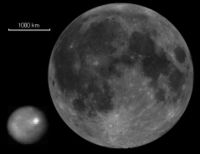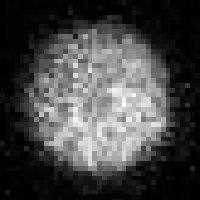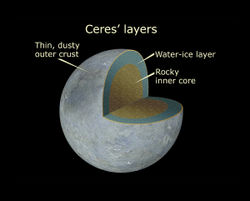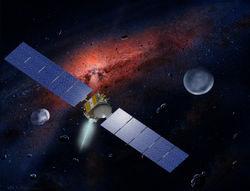Ceres (dwarf planet)
2007 Schools Wikipedia Selection. Related subjects: Space (Astronomy)
 |
|
| Discovery A | |
|---|---|
| Discoverer | Giuseppe Piazzi |
| Discovery date | January 1, 1801 |
| Alternate designations B |
A899 OF; 1943 XB |
| Category | Main belt, Dwarf Planet |
| Orbital elements C | |
|
|
|
| Eccentricity (e) | 0.080 |
| Semi-major axis (a) | 413.715 Gm (2.766 AU) |
| Perihelion (q) | 380.612 Gm (2.544 AU) |
| Aphelion (Q) | 446.818 Gm (2.987 AU) |
| Orbital period (P) | 1679.819 d (4.599 a) |
| Mean orbital speed | 17.882 km/ s |
| Inclination (i) | 10.587 ° |
| Longitude of the ascending node (Ω) |
80.410° |
| Argument of perihelion (ω) |
73.271° |
| Mean anomaly (M) | 108.509° |
| Physical characteristics D | |
| Dimensions | 975×909 km |
| Mass | 9.46 ± 0.04 × 1020 kg |
| Density | 2.08 g/ cm³ |
| Surface gravity | 0.27 m/s² |
| Escape velocity | 0.51 km/s |
| Rotation period | 0.3781 d |
| Spectral class | G-type asteroid |
| Absolute magnitude | 3.34 |
| Albedo ( geometric) | 0.113 |
| Mean surface temperature |
~167 K max: 239 K (-34 ° C) |
Ceres ( IPA /ˈsiːriz/, Latin: Cerēs), also designated 1 Ceres or (1) Ceres (See Minor Planet Names), is the smallest dwarf planet in the Solar System and the only one located in the main asteroid belt. Its name is derived from the Roman goddess Ceres — the goddess of growing plants and of motherly love. It was discovered on January 1, 1801, by Giuseppe Piazzi. With a diameter of about 950 km, Ceres is by far the largest and most massive body in the asteroid belt, and contains approximately a third of the belt's total mass. Recent observations have revealed that it is spherical, unlike the irregular shapes of smaller asteroids with less gravity.
Name
Ceres was originally named Ceres Ferdinandea (Cerere Ferdinandea) after both the mythological figure Ceres (Roman goddess of plants and motherly love) and King Ferdinand III of Sicily. "Ferdinandea" was not acceptable to other nations of the world and was thus dropped. Ceres was also called Hera for a short time in Germany. In Greece, it is called Δήμητρα ( Demeter), after the goddess Ceres' Greek equivalent; in English usage, Demeter is the name of a different asteroid ( 1108 Demeter).
Due to the rarity of the usage, there is no consensus as to the proper adjectival form of the name, although the nonce forms Cerian and Cerean have been used in fiction. Grammaticially, the form Cererean would be correct (cf. its genetive, Cereris).
Symbol
Ceres' astronomical symbol is a sickle (![]() ), similar to Venus' symbol (
), similar to Venus' symbol (![]() ) which is the female gender symbol and Venus' hand mirror. There have been several variants of the sickle design, including
) which is the female gender symbol and Venus' hand mirror. There have been several variants of the sickle design, including ![]() ,
, ![]() and
and ![]() .
.
Discovery
Piazzi was searching for a star listed by Francis Wollaston as Mayer 87 because it was not in Mayer's zodiacal catalogue in the position given. Instead, Piazzi found a moving star-like object, which he thought at first was a comet.
Piazzi observed Ceres a total of 24 times, the final time on February 11, when illness interrupted. On January 24, 1801, Piazzi announced his discovery in letters to fellow astronomers, among them his fellow countryman, Barnaba Oriani of Milan. He reported it as a comet but "since its movement is so slow and rather uniform, it has occurred to me several times that it might be something better than a comet". In April, Piazzi sent his complete observations to Oriani, Bode, and Lalande in Paris. They were shortly thereafter published in the September, 1801 issue of the Monatliche Correspondenz.
To recover Ceres, Carl Friedrich Gauss, then only 24 years old, developed a method of orbit determination from three observations. In only a few weeks, he predicted its path, and sent his results to Franz Xaver, Baron von Zach, the editor of the Monatliche Correspondenz. On December 31, 1801, von Zach and Heinrich W. M. Olbers unambiguously confirmed the recovery of Ceres.
Status

Johann Elert Bode believed Ceres to be the "missing planet" that Johann Daniel Titius had proposed to exist between Mars and Jupiter, at a distance of 419 million km (2.8 AU) from the Sun. Ceres was assigned a planetary symbol, and remained listed as a planet in astronomy books and tables (along with 2 Pallas, 3 Juno and 4 Vesta) for about half a century until further asteroids were discovered. Due to Ceres' small size, its relatively high inclination, and its sharing an orbital region with 2 Pallas, Sir William Herschel coined in 1802 the term asteroid ("star-like") for such bodies, writing, "they resemble small stars so much as hardly to be distinguished from them, even by very good telescopes".
The 2006 debate surrounding Pluto and what constitutes a 'planet' led to Ceres being considered for reclassification as a planet. An unsuccessful proposal before the International Astronomical Union for the definition of a planet would have defined a planet as "a celestial body that (a) has sufficient mass for its self-gravity to overcome rigid body forces so that it assumes a hydrostatic equilibrium (nearly round) shape, and (b) is in orbit around a star, and is neither a star nor a satellite of a planet". Had this resolution been adopted, this would have made Ceres the fifth planet in order from the Sun. Instead, the new definition of 'planet' is "a celestial body that is in orbit around the sun, has sufficient mass for its self-gravity to overcome rigid body forces so that it assumes a ... nearly round shape, and has cleared the neighbourhood around its orbit." By this definition, Ceres (along with Pluto) cannot be classified as a planet, and both are now classified as " dwarf planets".
The classification of Ceres has changed more than once. At the time of its discovery it was considered a planet, but upon the realization that it represented the first of a class of many similar bodies, it was reclassified as an asteroid for over 150 years. As the first such body to be discovered, it was given the designation 1 Ceres under the modern system of asteroid numbering. After the discovery of the trans-Neptunian object Eris, the International Astronomical Union put forward a proposal to once again define Ceres as a planet, along with Eris and Pluto's moon Charon. This draft definition was not accepted, and in its place an alternate definition of "planet" came into effect as of August 24, 2006. Under this definition, Ceres is a 'dwarf planet', although it remains unclear as to whether or not it is also classified as an asteroid.
Orbit
Ceres follows an orbit between Mars and Jupiter, within the main asteroid belt, with a period of 4.6 years. The orbit is moderately inclined (i=10.6° to be compared with 7° for Mercury and 17° for Pluto) and moderately eccentric (e=0.08 to compare with 0.09 for Mars).
The diagram illustrates the orbits of Ceres (blue) and several planets (white/grey). The segments of orbits below the ecliptic are plotted in darker colours, and the orange plus sign is the Sun's location. The top left diagram is a polar view that shows the location of Ceres in the gap between Mars and Jupiter. The top right is a close-up demonstrating the locations of the perihelia (q) and aphelia (Q) of Ceres and Mars. Interestingly, the perihelia of Ceres (as well as those of several other of the largest MBAs) and Mars are on the opposite sides of the Sun. The bottom diagram is a perspective view showing the inclination of the orbit of Ceres compared to the orbits of Mars and Jupiter.
Physical characteristics


Ceres is the largest object in the asteroid belt, which mostly lies between Mars and Jupiter. However, it is not the largest object besides the Sun, planets and their satellites, in the solar system: the Kuiper belt is known to contain larger objects, including Eris, Pluto, 50000 Quaoar, 90482 Orcus, and 90377 Sedna.
At certain points in its orbit, Ceres can reach a magnitude of 7.0. This is generally regarded as being just barely too dim to be seen with the naked eye, but under exceptional viewing conditions a very sharp-sighted person may be able to see the asteroid with the naked eye. The only other asteroid that can be seen with the naked eye is 4 Vesta.
Ceres' size and mass are sufficient to give it a nearly spherical shape. That is, it is close to hydrostatic equilibrium. Other large asteroids such as 2 Pallas, 3 Juno, and 4 Vesta are known to be quite irregular, while lightcurve analysis of 10 Hygiea indicates it is oblong although it appears spheroidal in low-resolution images (presumably due to viewing angle).
With a mass of 9.5×1020 kg, Ceres comprises about a third of the estimated total 3.0±0.2×1021 kg mass of all the asteroids in the solar system (note how all these amount to only about 4% of the mass of the Moon).
There are some indications that the surface of Ceres is relatively warm and that it may have a tenuous atmosphere and frost. The maximum temperature with the Sun overhead was estimated from measurements to be 235 K (about -38 ° C) on May 5, 1991. Taking into account also the heliocentric distance at the time, this gives an estimated maximum of ~239 K at perihelion.
A study led by Peter Thomas of Cornell University suggests that Ceres has a differentiated interior: observations coupled with computer models suggest the presence of a rocky core overlain with an icy mantle. This mantle of thickness from 120 to 60 km could contain 200 million cubic kilometres of water, which is more than the amount of fresh water on the Earth.
There has been some ambiguity regarding surface features on Ceres. Low resolution ultraviolet Hubble Space Telescope images taken in 1995 showed a dark spot on its surface which was nicknamed "Piazzi" in honour of the discoverer of Ceres. This was thought to be a crater. Later images with a higher resolution taken over a whole rotation with the Keck telescope using adaptive optics showed no sign of "Piazzi". However, two dark features were seen to move with the asteroid's rotation, one with a bright central region. These are presumably craters. More recent visible light Hubble Space Telescope images of a full rotation taken in 2003 and 2004 show an enigmatic white spot, the nature of which is currently unknown. The dark albedo features seen with Keck are, however, not immediately recognizable in these images.
These last observations also determined that Ceres' north pole points (give or take about 5°) in the direction of right ascension 19 h 24 min, declination +59°, in the constellation Draco. This means that Ceres' axial tilt is very small (about 4±5°).
Ceres was long thought to be the parent body of the "Ceres asteroid family". However, that grouping is now defunct because Ceres has been shown to be an interloper in its "own" family, and physically unrelated. The bulk of that asteroid group is now called the Gefion family.
Observations
Some notable observation milestones for Ceres include:
An occultation of a star by Ceres was observed in Mexico, Florida and across the Caribbean on November 13, 1984.
Features on Ceres' surface have been telescopically imaged several times in recent years.
These include:
- Ultraviolet Hubble Space Telescope images with 50 km resolution taken in 1995.
- Visible images with 60 km resolution taken with the Keck telescope in 2002 using adaptive optics.
- Infrared images with 30 km resolution also taken with the Keck telescope in 2002 using adaptive optics.
- The best resolution to date (30 km) visible light images using Hubble again in 2003 and 2004.
Radio signals from spacecraft in orbit around Mars and on its surface have been used to estimate the mass of Ceres from the perturbations induced by it onto the motion of Mars.
Exploration of Ceres
To date no space probes have visited Ceres. However, NASA is currently developing the Dawn Mission, with a projected launch in 2007. According to the current mission profile, Dawn is expected to explore the asteroid 4 Vesta in 2011 before arriving at Ceres in 2015.
Namesakes
- The chemical element cerium (atomic number 58) was discovered in 1803 by Berzelius and Klaproth, working independently. Berzelius named the element after Ceres.
- William Hyde Wollaston discovered palladium (atomic number 46) as early as 1802 and at first called it Ceresium. By the time he openly published his discovery in 1805, the name was already taken (by Berzelius) and he switched it to palladium in honour of 2 Pallas.
Aspects
| Stationary, retrograde |
Opposition | Distance to Earth ( AU) |
Maximum brightness (mag) |
Stationary, prograde |
Conjunction to Sun |
|---|---|---|---|---|---|
| March 21, 2005 | May 8, 2005 | 1.68631 | 7.0 | June 30, 2005 | December 28, 2005 |
| June 26, 2006 | August 12, 2006 | 1.98278 | 7.6 | November 27, 2006 | March 22, 2007 |
| September 20, 2007 | November 9, 2007 | 1.83690 | 7.2 | January 1, 2008 | June 28, 2008 |
| January 17, 2009 | February 24, 2009 | 1.58526 | 6.9 | April 16, 2009 | October 31, 2009 |
| April 28, 2010 | June 18, 2010 | 1.81988 | 7.0 | August 9, 2010 | January 30, 2011 |
| July 31, 2011 | September 16, 2011 | 1.99211 | 7.7 | November 12, 2011 | April 26, 2012 |
| October 30, 2012 | December 17, 2012 | 1.68842 | 6.7 | February 4, 2013 | August 17, 2013 |
| March 1, 2014 | April 15, 2014 | 1.63294 | 7.0 | June 7, 2014 | December 10, 2014 |
| June 6, 2015 | July 25, 2015 | 1.94252 | 7.5 | September 16, 2015 | March 3, 2016 |
| September 1, 2016 | October 20, 2016 | 1.90844 | 7.4 | December 15, 2016 | June 5, 2017 |
| December 21, 2017 | January 31, 2018 | 1.59531 | 8.8 | March 20, 2018 | October 7, 2018 |
| April 9, 2019 | May 29, 2019 | 1.74756 | 7.0 | July 20, 2019 | January 14, 2020 |
| July 13, 2020 | August 28, 2020 | 1.99916 | 7.7 | October 23, 2020 | April 7, 2021 |



